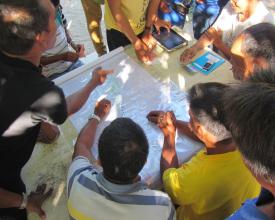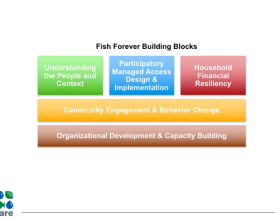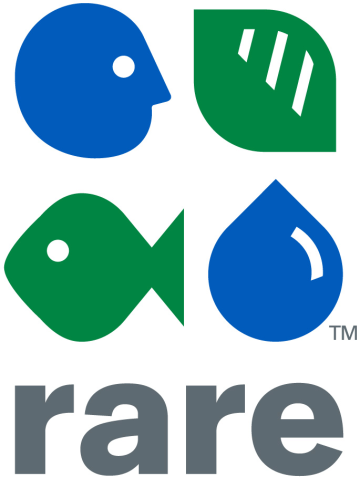
Fish Forever aux Philippines : Campagne pour un accès contrôlé et des sanctuaires
Solution complète
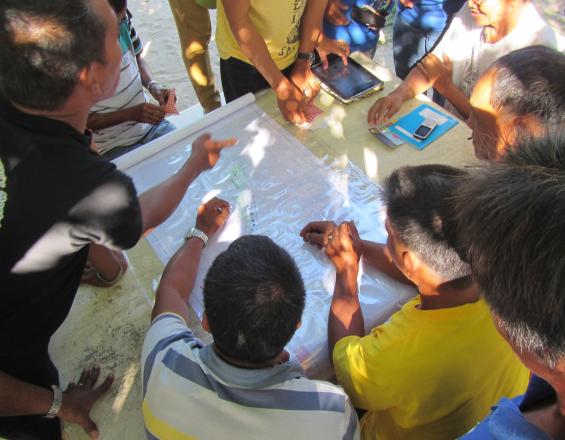
Atelier sur le zonage côtier à Looc et Lubang
Rare
Une campagne de marketing social et de changement de comportement est mise en œuvre pour encourager la communauté à soutenir la mise en place de zones d'accès aménagées et de sanctuaires, une approche de gestion de la pêche qui désigne des zones de pêche exclusives pour certains groupes de pêcheurs en échange du respect de pratiques de pêche plus durables. Cette approche est associée à une stratégie de résilience des ménages visant à renforcer les actifs financiers des ménages qui soutiennent le programme.
Dernière modification 30 Sep 2020
11795 Vues
Contexte
Défis à relever
Environnementale : Les zones de pêche autour de Looc ont été surexploitées et la taille des poissons capturés a diminué au cours des dernières années. Social : Les pêcheurs savent que leurs eaux sont surexploitées, mais se méfient des nouvelles approches de gestion qui pourraient restreindre encore plus leur pêche. La mise en place de zones d'accès aménagées autour de zones interdites à la pêche ou de sanctuaires nécessite une forte adhésion de la communauté, un accord sur les zones à délimiter, la confiance et une coopération constante entre le gouvernement local, les chefs de village locaux et les groupes de pêcheurs. Économique : La pêche est la principale source de revenus à Looc. L'adoption de pratiques plus durables et la limitation de l'accès à certaines zones de pêche nécessiteront des alternatives viables ou des moyens de subsistance supplémentaires.
Emplacement
Looc, Mindoro occidental, Philippines
Asie du Sud-Est
Traiter
Résumé du processus
Le processus passe par plusieurs étapes, notamment la compréhension des personnes et du contexte, le processus de conception et la mise en œuvre, et le renforcement de la résilience financière des ménages, mais il est toujours étayé par les éléments constitutifs de l'engagement communautaire et du changement de comportement, ainsi que par le développement organisationnel et le renforcement des capacités. Ces deux éléments essentiels doivent accompagner toutes les étapes du processus afin de les rendre efficaces et durables.
Blocs de construction
Comprendre les personnes et le contexte
Des recherches qualitatives et quantitatives sont menées pour établir des profils des pêcheries et des pêcheurs, afin de documenter les lieux, les engins et les pratiques de pêche actuels. Les connaissances, les attitudes et les sources d'information actuelles sont également mesurées.
Facteurs favorables
Les processus participatifs ont permis à la communauté de valider les informations et de les accepter comme base pour les décisions futures - Une institution universitaire partenaire a apporté son expertise technique et sa crédibilité auprès de la communauté.
- Des projets antérieurs dans la région ont également fourni des informations scientifiques précieuses.
Leçon apprise
Il ne faut pas sous-estimer le temps nécessaire pour éduquer les pêcheurs et la communauté sur les ressources côtières de base et la gestion de la pêche. Il est important de multiplier les sessions d'écoute et les discussions pour favoriser la compréhension et le soutien.
Conception et mise en œuvre d'un accès géré participatif
À l'aide des données issues du profilage, les pêcheurs et les dirigeants communautaires participent à une série d'ateliers qui les guident dans a) la définition des objectifs communautaires en matière de pêche et de conservation, b) le zonage et le marquage de leurs eaux municipales, c) l'évaluation de leurs réserves, d) la délimitation des zones d'accès contrôlé et e) l'adoption de règles au sein de leurs zones d'accès contrôlé. Lorsque ces règles ont été convenues, elles sont codifiées dans une politique et des dispositions institutionnelles en vue d'une mise en œuvre continue.
Facteurs favorables
L'adhésion du maire et du conseil législatif local a contribué à stimuler le processus dans les communautés, et les zones de gestion précédemment désignées ont servi de points de départ pour la poursuite de l'aménagement du territoire.
Leçon apprise
Les apports de la première étape ont été essentiels pour instaurer la confiance pour cette étape. Il était important que toutes les discussions et tous les accords conclus au cours des ateliers soient partagés avec les communautés lors des sessions de consultation et de retour d'information avant de passer à l'étape suivante du processus de conception.
Engagement communautaire et changement de comportement
L'équipe de campagne de chaque municipalité utilise un mélange de matériel créatif et d'activités de mobilisation communautaire pour inspirer et éduquer les pêcheurs et leurs familles sur les avantages de travailler ensemble pour mieux gérer leurs pêcheries. Au cours de la phase de préparation, les messages visent à inciter les pêcheurs à s'enregistrer, à respecter les lois fondamentales en matière de pêche et à participer aux réunions. Dans la deuxième phase, après la légalisation des zones d'accès aménagées, les messages se concentrent sur le respect des règles de l'AAM+S et sur la surveillance continue de leurs prises.
Facteurs favorables
Fort sentiment d'appartenance et d'identité parmi les pêcheurs de l'île ; soutien actif des dirigeants municipaux et villageois ; personnel motivé et efficace.
Leçon apprise
Il existe de nombreux points communs entre les sites, de sorte que la campagne a pu utiliser du matériel adopté par les autres municipalités qui ont également fait pression en faveur d'une gestion de base de la pêche. L'adaptation locale, en particulier des activités de mobilisation, a permis de rendre les campagnes plus spécifiques au site et plus "appropriables" par la communauté.
Développement organisationnel et renforcement des capacités
Plusieurs organisations essentielles au sein de la communauté doivent être développées ou renforcées. La campagne doit veiller à ce que les conseils de pêche, les organes de gestion et les associations de pêcheurs soient organisés et fonctionnent bien. Ils sont formés sur des sujets tels que la gestion adaptative des pêches, les principes de gestion, la gestion des bénévoles et la constitution d'équipes.
Facteurs favorables
Ouverture à la coopération et à l'apprentissage.
Leçon apprise
Le fonctionnement et le soutien des conseils de pêche, des organes de gestion et des associations de pêcheurs sont nécessaires au succès de la campagne "Fish forever".
Culture financière et résilience
Pour passer à une pêche plus durable, les pêcheurs devaient constituer une épargne afin de protéger leurs ménages contre les crises et les chocs. Des clubs d'épargne ont été organisés dans toute la municipalité sur le modèle de l'association villageoise d'épargne et de prêt. Au bout de neuf mois, quatre clubs comptant 95 membres avaient été créés et chaque membre avait épargné en moyenne 3 200 pesos philippins.
Facteurs favorables
L'approche VSLA comporte des garanties solides pour promouvoir la responsabilisation des membres ; le bouche à oreille a encouragé d'autres ménages de pêcheurs à adhérer.
Leçon apprise
Les épouses des pêcheurs jouent un rôle essentiel dans la constitution de l'épargne des ménages et doivent être contactées. Il est également important d'échanger des histoires sur l'utilisation de l'épargne, comme les urgences médicales ou la subsistance de la famille pendant les jours où le temps est mauvais pour la pêche, afin de s'encourager mutuellement à poursuivre dans cette voie.
Impacts
1 144 hectares d'eaux municipales ont été légalement déclarés zone d'accès géré + sanctuaire, ce qui permettra de protéger les habitats essentiels et d'accorder un accès exclusif aux pêcheurs qui respectent des pratiques plus durables. Plus de 800 pêcheurs ont été sensibilisés aux pratiques de pêche durables et ont participé à des sessions de renforcement des connaissances et de prise de décision.
Bénéficiaires
Pêcheurs, associations de pêcheurs, conseil municipal de gestion des ressources halieutiques et aquatiques, administration municipale locale, y compris les membres du bureau de l'agriculture, du conseil législatif et de la mairie.
Histoire
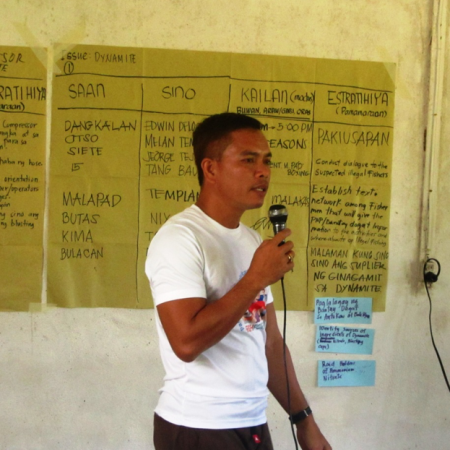
Jose Ambrocio
Jose Ambrocio
En tant qu'insulaire, la vie était rude, avec des difficultés d'accès à l'eau potable et à l'électricité. Dans notre ville, les moyens de subsistance proviennent essentiellement de la pêche. Pendant mon enfance et mon adolescence, j'ai pratiqué la pêche à la dynamite et je me suis engagé comme membre d'équipage d'un navire de pêche commerciale au chalut.
Cependant, après tant d'années passées à pratiquer des activités de pêche illégales, j'ai commencé à m'intéresser au service public, en siégeant au conseil des jeunes de notre village. J'ai été élu président des jeunes du village et j'ai été embauché par le bureau municipal de l'agriculture de notre municipalité.
J'ai ensuite été élu conseiller municipal et choisi comme président de la commission de l'agriculture et de l'environnement. En tant que conseiller municipal, j'ai participé à des programmes de gestion des ressources halieutiques côtières soutenus par des organisations non gouvernementales et des agences gouvernementales nationales. Tout d'abord, avec l'aide de Conservation International, j'ai dirigé l'équipe chargée de créer des zones marines protégées. Aujourd'hui, avec la campagne Fish Forever de Rare, nous nous efforçons de trouver un équilibre entre les besoins économiques de la population et la nécessité de conserver les ressources pour les générations futures. Les pêcheurs viennent maintenant me voir pour me dire qu'ils comprennent mieux ce que nous essayons de faire.
Connexion avec les contributeurs
Autres contributeurs
Jose Ambrocio
Municipalité de Looc, Mindoro Occidental / Rare
Rocky Sanchez Tirona
Rare
Fel Cesar Cadiz
Rare
Isaac Abello
Rare
Art Faburada
Rare
